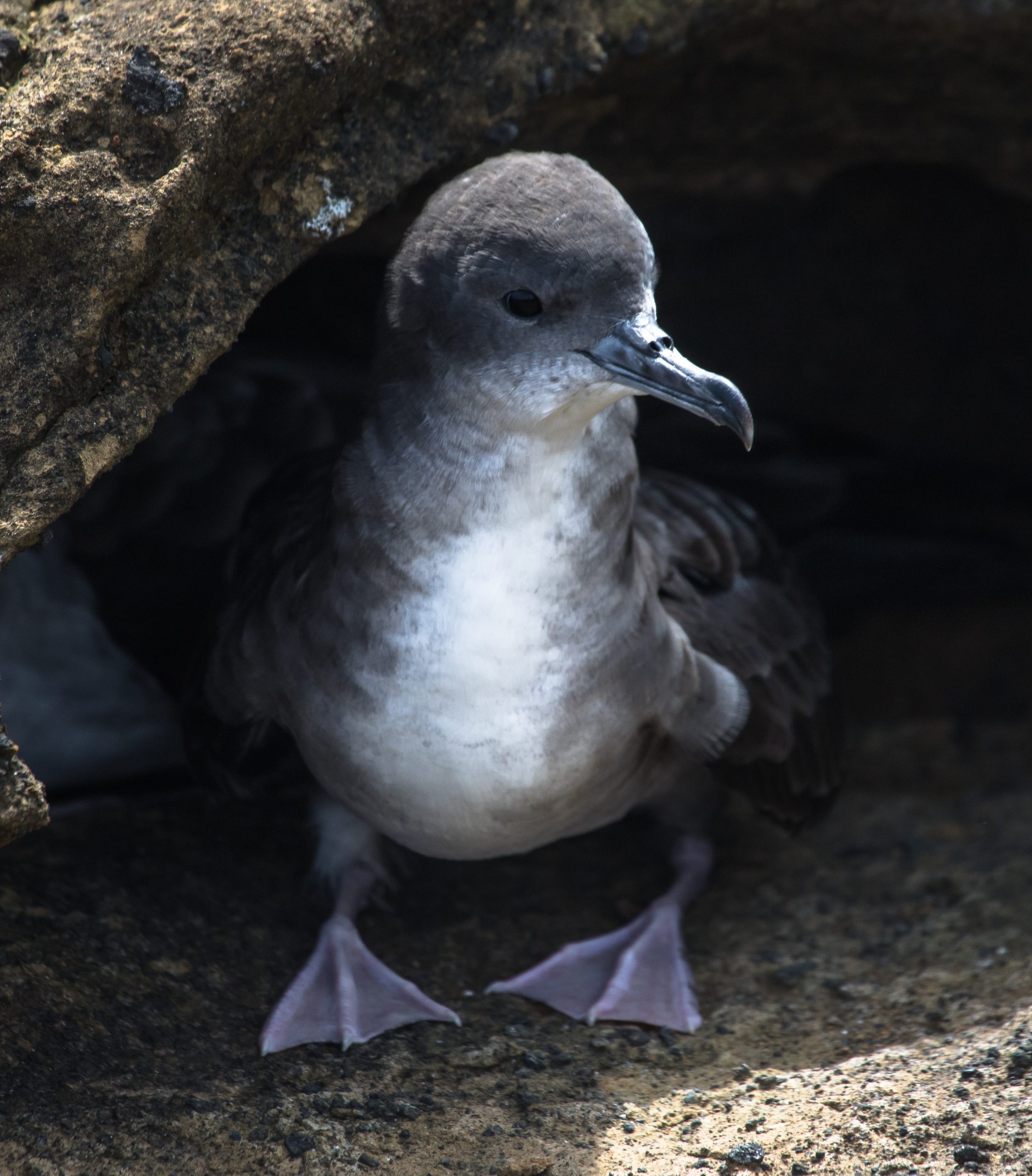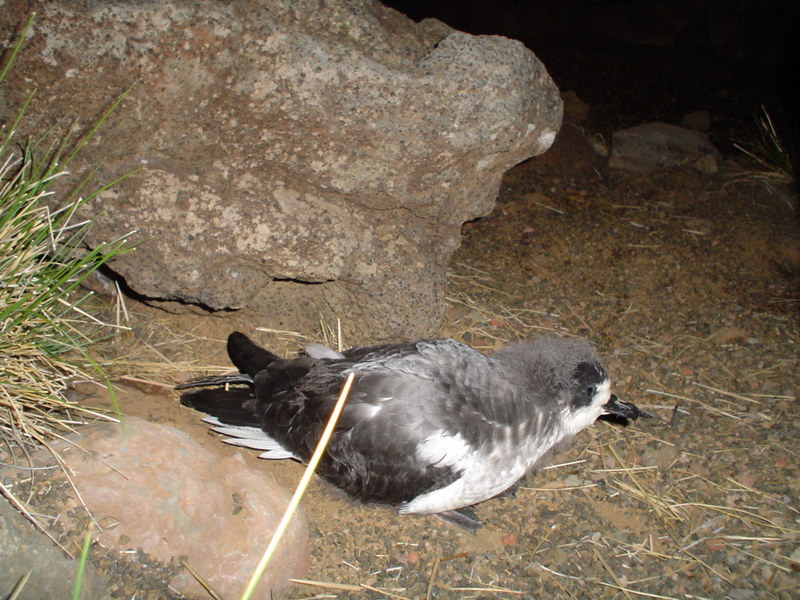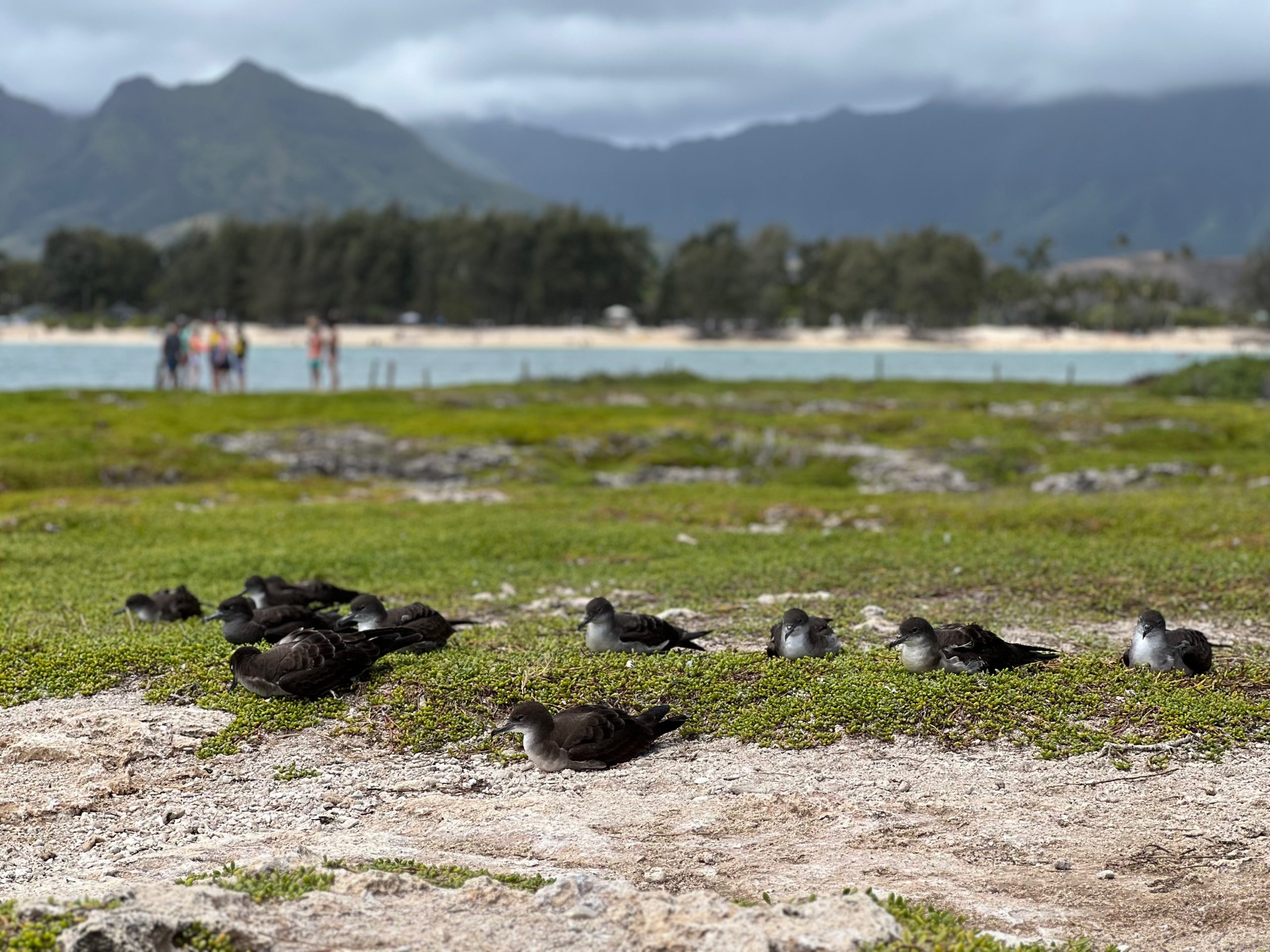‘Ua‘u kani
Names
- ʻŌlelo Hawaiʻi: ‘Ua‘u kani
- Common: Wedge-tailed shearwater
- Scientific: Ardenna pacifica, Puffinus pacificus
Song
Conservation Status
- IUCN Red List Ranking – Least Concern
Species Information
The ‘ua‘u kani or wedge-tailed shearwater is a large, abundant seabird (Family: Procellaridae) that produces a variety of wails and moans that surely inspired the Hawaiian name of this bird which means “calling or moaning petrel.” Individuals have long thin wings, a wedge-shaped tail, and a hooked bill. ‘Ua‘u kani are polymorphic, having two color phases, dark or light, and sexes are similar in appearance. Light-phase adults are grayish brown above with white underparts except for dark trailing edges of wings and tail. Dark-phase adults are uniformly sooty brown. Flight is similar to that of albatross but flaps wings with greater frequency. Often forages in large, mixed species hunting groups associated with schools of large predatory fishes which drive prey species to the surface. They use a variety of foraging techniques, most frequently plunges head into water while on the wing, also seizes prey while sitting on the water; often follows fishing vessels. In Hawai‘i, diet primarily consists of larval goatfish, flyingfish, squirrelfish, and flying squid. Like most seabirds ‘ua‘u kani breed in natal colonies, form long-term pair bonds, have high site fidelity, lay one egg per season, and both parents participate in all aspects of raising young. In Hawai‘i, nesting is synchronous, and most eggs are laid in June with most young fledging in November. Birds first breed at four years of age, and the oldest known individual was 29 years old.
Distribution
Nests throughout the Northwestern Hawaiian Islands (NHWI) and on offshore islets of most of the Main Hawaiian Islands (MHI). Outside of Hawai‘i, nests on islands throughout the tropical and subtropical Indian and Pacific oceans. After the breeding season, they may migrate to the eastern Pacific Ocean.
Habitat
Terrestrial: Nests on low, flat islands and sand spits with little or no vegetation, but also excavates burrows on the slopes of extinct volcanoes and in old volcanic craters. Burrows require firm soil or plant roots to stabilize loose soil; generally nesting habitat is devoid of tall woody plants. In locations where nest sites are scarce or the ground is too hard to excavate burrows, birds will nest in rock crevices or above ground. Marine: Pelagic.
Threats
- Introduced predators. Like many seabirds, adults and nests are susceptible tomammalian predation by pigs (Sus scrofa), rats (Rattus spp.), feral cats (Felis silvestris), and the small Indian mongoose (Herpestes auropunctatus).
- Human disturbance. Laysan (Telespiza cantans) and Nihoa (T. ultima) finches will depredate eggs left unattended because of human disturbance. Trampling by humans can collapse burrows.
- Artificial lighting. Street and resort lights, especially in coastal areas, disorient fledglings, causing them to eventually fall to the ground exhausted or increasing their chance of collision with structures (i.e., fallout). Once on the ground, fledglings are unable to fly and are killed by cars, cats, and dogs or die of starvation or dehydration.
- Overfishing. Because ‘ua‘u kani rely on predatory fish to drive prey to the surface, overfishing may be affecting Hawaiian populations.
- Contaminants. Mercury, lead, and organochlorines have been detected in Hawaiian birds.
- Disease. Pox-like lesions have been observed on birds breeding on Maui and Moloka‘i.
Learn more
Plans & Projects
- Kauaʻi Endangered Seabird Recovery Project (KESRP)
- Maui Nui Seabird Recovery Project (MNSRP)
- Lehua Island Ecosystem Restoration Project
- Kaʻena Point Ecosystem Restoration Project
Photos
Additional Resources
For more information and references visit the DLNR State Wildlife Action Plan factsheets. DOFAWʻs species pages and State Wildlife Action Plan fact sheets are provided for general information and are not meant to be a citable, original source of data. If you are a student, researcher, or writer looking for a citable source, please explore the references below or find other original data sources, rather than citing these webpages. The references below were provided by the authors of the State Wildlife Action Plan fact sheets at the time of drafting:
- Hawai’i Natural Heritage Program [Hawai‘i Biodiversity and Mapping Program]. 2004. Natural diversity database. University of Hawai’i, Center for Conservation Research and Training. Honolulu, Hawai‘i.
- IUCN Red List of Threatened Species. Version 2014.3. www.iucnredlist.org. (Accessed May 2015).
- Kushlan JA, et al. 2002. Waterbird Conservation for the Americas: The North American waterbird conservation plan, Version 1 Waterbird Conservation for the Americas, Washington, DC. 78pp. Available at: www.waterbirdconservation.org.
- NatureServe. 2003. Downloadable animal data sets. NatureServe Central Databases. Available at: https://www.natureserve.org/getData/vertinvertdata.jsp (March 10, 2005).
- U.S. Fish and Wildlife Service. 2005. Regional seabird conservation plan, Pacific Region. U.S. Fish and Wildlife Service, Migratory Birds and Habitat Programs, Pacific Region. Portland, Oregon.
- Whittow GC. 1997. Wedge-tailed shearwater (Puffinus pacificus). In The Birds of North America, No. 305 (Poole A, Gill F, editors.). Philadelphia, (PA): The Academy of Natural Sciences; and Washington DC: The American Ornithologists’ Union.





